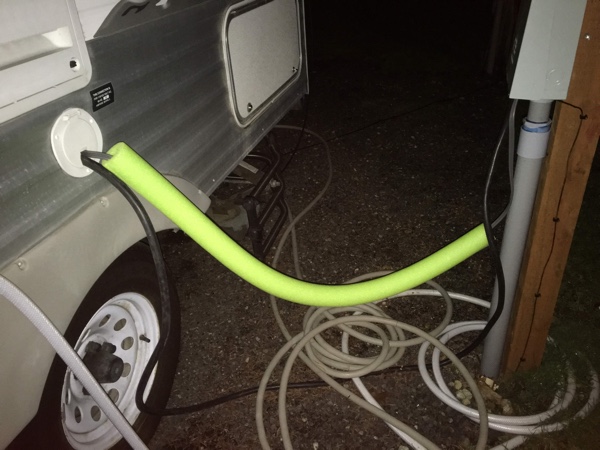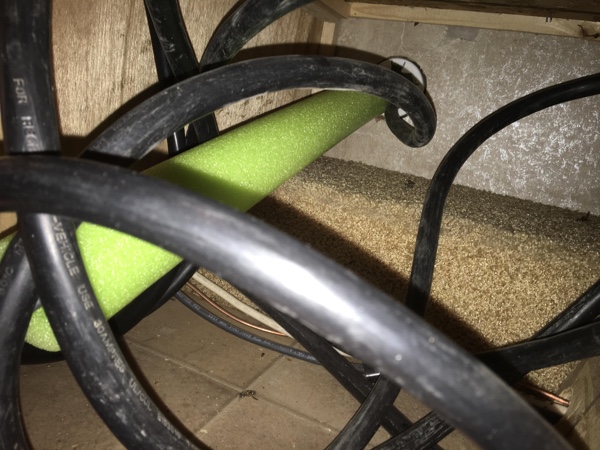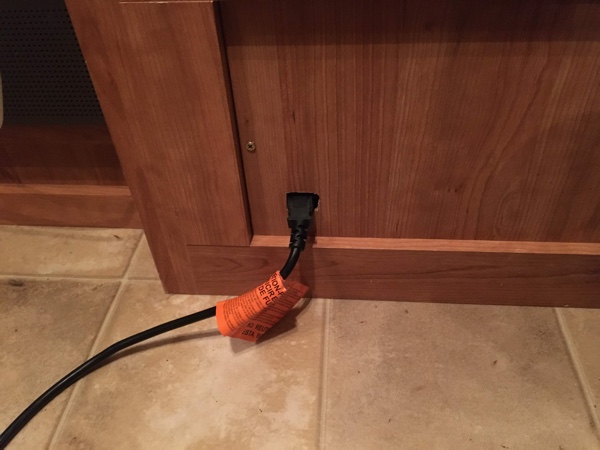
Monday, December 9, 2019
I’ve been using an electric space heater as my primary heat source since moving into my little trailer last March. I do have propane, but using a propane furnace makes me a little uncomfortable. In fact, using propane anything makes me a little nervous. I only turn on my hot water heater when I need large amounts of hot water, and I mostly use small electronic appliances for cooking.
But this reliance on electricity has some constraints. Namely, my little trailer is limited to 30 amps, and my space heater requires 15.  If I want to cook, I have to turn off the heater. I’ve only tripped the breaker once, but I don’t want to have to worry about tripping breakers. Moreover, I don’t have enough outlets, so the heater has always been plugged into a surge strip. Not a good idea as surge strips are not made for such high power draws. I don’t want to set my little home on fire.
If I want to cook, I have to turn off the heater. I’ve only tripped the breaker once, but I don’t want to have to worry about tripping breakers. Moreover, I don’t have enough outlets, so the heater has always been plugged into a surge strip. Not a good idea as surge strips are not made for such high power draws. I don’t want to set my little home on fire.
I remembered the park manager had told me there’s an available 20-amp outlet on the power pole. I just needed a heavy duty extension cord. I had done something similar with a motorhome I lived in for a bit in 1996, and it worked really well, nearly doubling the amount of power available available for my appliances.
I checked the existing power cable port on the side of my trailer. It was big enough that I could run another cable through the opening, so I wouldn’t have to cut another hole in the outside. I’d only need to cut a hole on the inside.
I verified the amps on my heater–yes, it is 15 amps–and headed over to Home Depot to take a look at their extension cords. In particular, I wanted something with a flat plug so the electric box could remain as closed as possible, protecting the outlets from weather.
 This requirement was a bit problematic. None of the heavy-duty extension cords had flat plugs. I couldn’t find an adapter, either. However, I found a 15-amp flat-plug appliance extension cord. The stated purpose on the label is for “Refrigerators, microwaves, air conditioners, and other appliances.” I know air conditioners draw a lot of power, so the cord should work for a heater.
This requirement was a bit problematic. None of the heavy-duty extension cords had flat plugs. I couldn’t find an adapter, either. However, I found a 15-amp flat-plug appliance extension cord. The stated purpose on the label is for “Refrigerators, microwaves, air conditioners, and other appliances.” I know air conditioners draw a lot of power, so the cord should work for a heater.
I had been looking for something at least 15 feet long. This one was only nine feet, but it could work. My trailer is parked really close to the power pole.
I picked up two, just in case one wasn’t long enough. There was a 20-amp version of the same cord, but the prongs were wrong for my outlet. Fifteen amp was my only choice.
The cord’s flat plug fit nicely in the power box, allowing the lid to fully close, protecting the plugs and outlets. I poked the other end through the electrical port on the side of the trailer and pushed in a couple of feet of cord, enough that I should be able to reach it inside. Unfortunately, the cord itself was no longer able to reach the ground, creating a tripping hazard. I didn’t want anyone tripping over my cord, potentially knocking over my heater.
But first, see if this plan would even work.
 I went inside and removed the panel cover under the refrigerator. I could see the cord I had shoved through the hole, I reached under and pulled it through. It just barely reached inside the trailer.
I went inside and removed the panel cover under the refrigerator. I could see the cord I had shoved through the hole, I reached under and pulled it through. It just barely reached inside the trailer.
Just barely was all I needed.
I plugged in the heater to test it. No power. I checked the breaker at the box. It was turned off. I switched the breaker on and went back in to check.
Power! This would work!
I used a bright lime green pool noodle to cover the extension cord outside, making it more highly visible and more difficult to accidentally pull through into the trailer. I then used another pool noodle to cover the extension cord inside the trailer. Again, this would make it more difficult to pull the extension cord back outside. This should make the extension cord secure enough.
 All I needed now was a hole in the access panel big enough for the plug to go through. I removed the access panel and drew an outline of the plug on the front. This next part was a little tricky because I didn’t want to damage the access panel, and it is pretty flimsy, more veneer than wood.
All I needed now was a hole in the access panel big enough for the plug to go through. I removed the access panel and drew an outline of the plug on the front. This next part was a little tricky because I didn’t want to damage the access panel, and it is pretty flimsy, more veneer than wood.
However, it proved to be more difficult to cut than it looked.
I scored the outline with my pocket knife a couple of times, but the wood held solid. I then took a drill and used my smallest drill bit to drill holes in the wood every few millimeters. Still, the wood held solid. I even tried scoring it more.
It was not going to budge.
I searched my shed for my chisels, but couldn’t find them. I did, however, find a small flat-head screwdriver, a hammer, and a couple of razor blades. The screwdriver had a pretty thin blade; it might work. If not, the razor blades might. Either should cut with a couple of taps with the hammer.
I tried the screwdriver first, and it cut cleanly through the wood. Success! I followed the scored outline and soon had the opening cut out.
 The opening wasn’t quite big enough for the extension cord’s plug to go through, but it was for the heater’s plug. Good enough for me! I secured the panel and stood back to admire my work. I have to admit, it looks pretty good! I now have an additional 15 amps and a dedicated circuit for my heater, with very little effort or modifications to my trailer.
The opening wasn’t quite big enough for the extension cord’s plug to go through, but it was for the heater’s plug. Good enough for me! I secured the panel and stood back to admire my work. I have to admit, it looks pretty good! I now have an additional 15 amps and a dedicated circuit for my heater, with very little effort or modifications to my trailer.
Total cost: about $15 for the one extension cord. I could have used both, but it’s never a good idea to double up on cords. The connecting plugs would have to be inside the trailer in order to protect them from the elements, which would still leave cord hanging above the ground and a tripping hazard. I have no other use for it, so it can be returned.
By the way, I always have a good supply of pool noodles on hand. Pool noodles are almost as versatile as duct tape!